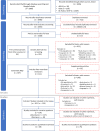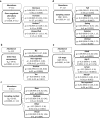How do changes in flow magnitude due to hydropower operations affect fish abundance and biomass in temperate regions? A systematic review
- PMID: 35136590
- PMCID: PMC8813579
- DOI: 10.1186/s13750-021-00254-8
How do changes in flow magnitude due to hydropower operations affect fish abundance and biomass in temperate regions? A systematic review
Abstract
Background: Altering the natural flow regime, an essential component of healthy fluvial systems, through hydropower operations has the potential to negatively impact freshwater fish populations. Establishing improved management of flow regimes requires better understanding of how fish respond to altered flow components, such as flow magnitude. Based on the results of a recent systematic map on the impacts of flow regime changes on direct outcomes of freshwater or estuarine fish productivity, evidence clusters on fish abundance and biomass responses were identified for full systematic review. The primary goal of this systematic review is to address one of those evidence clusters, with the following research question: how do changes in flow magnitude due to hydropower operations affect fish abundance and biomass?
Methods: This review follows the guidelines of the Collaboration for Environmental Evidence. It examined commercially published and grey literature originally identified during the systematic map process and a systematic search update. All articles were screened using an a priori eligibility criteria at two stages (title and abstract, and full-text) and consistency checks were performed at all stages. All eligible articles were assessed for study validity and specifically designed data extraction and study validity tools were used. A narrative synthesis included all available evidence and meta-analysis using the standardized mean difference (Hedges' g) was conducted where appropriate.
Review findings: A total of 133 studies from 103 articles were included in this systematic review for data extraction and critical appraisal. Most studies were from North America (60%) and were conducted at 146 different hydropower dams/facilities. Meta-analysis included 268 datasets from 58 studies, separated into three analyses based on replication type [temporal (within or between year replication) or spatial]. Fish abundance (226 datasets) and biomass (30 datasets) had variable responses to changes in flow magnitude with estimated overall mean effect sizes ranging from positive to negative and varying by study design and taxa. In studies with temporal replication, we found a detectable effect of alterations to the direction of flow magnitude, the presence of other flow components, sampling methods, season, and fish life stage. However, we found no detectable effect of these moderators for studies with spatial replication. Taxonomic analyses indicated variable responses to changes in flow magnitude and a bias towards salmonid species.
Conclusions: This synthesis did not find consistent patterns in fish abundance or biomass responses to alterations or changes in flow magnitude. Fish responses to flow magnitude alterations or changes were highly variable and context dependent. Our synthesis suggests that biotic responses may not be generalizable across systems impacted by hydroelectric power production and operations, where specific features of the system may be highly influential. Site-specific and adaptive management may be necessary. To improve study validity and interpretability, studies with long-term continuous monitoring, and both temporal and spatial replication are needed. When this gold standard is unfeasible, studies should strive, at minimum, to maximize replication within both intervention and comparator groups for either temporal or spatial designs. To further address knowledge gaps, studies are needed that focus on non-salmonids, multiple seasons, and systems outside of North America.
Supplementary information: The online version contains supplementary material available at 10.1186/s13750-021-00254-8.
Keywords: Anthropogenic impacts; Dam; Discharge; Evidence synthesis; Fish density; Flow modification; Hydroelectric power.
© The Author(s) 2022.
Conflict of interest statement
Competing interestsThe authors declare that they have no competing interests.
Figures














References
-
- Vitousek PM, Mooney HA, Lubchenco J, Melillo JM. Human domination of earth’s ecosystems. Science. 1997;277:494–9.
-
- Nilsson C, Reidy CA, Dynesius M, Revenga C. Fragmentation and flow regulation of the world’s large river systems. Science. 2005;308:405–8. - PubMed
-
- Winemiller KO, McIntyre PB, Castello L, Fluet-Chouinard E, Giarrizzo T, Nam S, et al. Balancing hydropower and biodiversity in the Amazon, Congo, and Mekong. Science. 2016;351:128–9. - PubMed
-
- Zarfl C, Lumsdon AE, Berlekamp J, Tydecks L, Tockner K. A global boom in hydropower dam construction. Aquat Sci. 2015;77:161–70.
-
- Grill G, Lehner B, Thieme M, Geenen B, Tickner D, Antonelli F, et al. Mapping the world’s free-flowing rivers. Nature. 2019;569:215–21. - PubMed
Publication types
LinkOut - more resources
Full Text Sources
